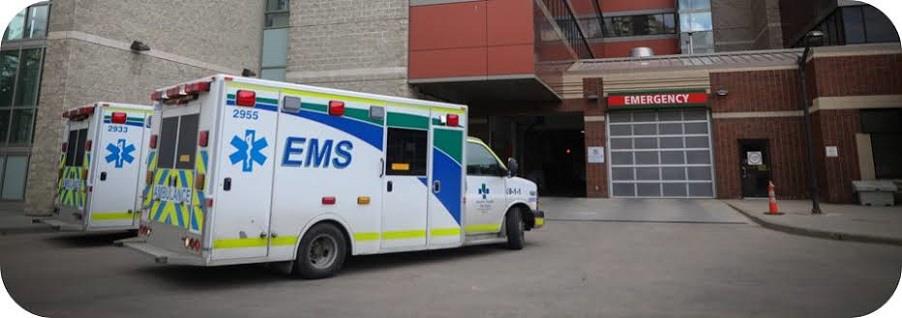Kashmir's EMS Crisis: The Lifeline Few Think To Call
Representational photo
By Dr. Nowsheen Jan
Every Kashmiri family has a story of rushing a loved one to the hospital. Sometimes it is a stroke in the middle of the night. Sometimes it is a road accident, or a child struggling to breathe. In those moments, what matters most is not how fast the car engine roars, but what kind of care begins before the hospital doors open.
For too long, an“ambulance” in Kashmir has meant a van with a driver and a stretcher. The global standard, however, has changed.
Emergency Medical Services, or EMS, are now fully equipped mobile hospitals. They carry advanced monitors, defibrillators, oxygen delivery systems, and a stock of life-saving medicines. More importantly, they are staffed with trained paramedics who can administer emergency treatment under the supervision of physicians. They are designed to buy patients the most precious commodity in a crisis: time.
Kashmir already has critical care ambulances. Yet very few people have the numbers stored in their phones. In moments of panic, families rely on neighbours or relatives, pushing patients into private vehicles. Sometimes patients drive themselves. These choices come with risks.
Survival in emergencies often depends on what happens in the first ten minutes, not on how quickly you reach a hospital building.
Imagine a cardiac arrest at home in Srinagar. Each minute without CPR or advanced life support reduces survival chances by about 10 percent. A trained EMS team can begin resuscitation instantly and keep the heart stable until arrival at a tertiary hospital.
Picture a severe allergic reaction in Shopian. A single injection administered by a paramedic can prevent the patient from slipping into anaphylactic shock. In these scenarios, treatment cannot wait for the hospital. The hospital must come to the patient.
The problem is perception. Many Kashmiris still view ambulances as“oxygen carriers” rather than full-fledged medical units. This misunderstanding keeps people from calling EMS when they need it most. There is also a trust gap. Families often believe they can manage better on their own, even as evidence worldwide shows that trained EMS improves survival rates dramatically.
Hospitals too share responsibility. When smaller facilities refer patients to tertiary centers, how often do they provide complete handover notes? How many paramedics receive proper updates about the patient's condition before transport?
In too many cases, a patient is transferred with little more than verbal instructions, leaving the EMS team to guess during emergencies on the road. Families, overwhelmed by stress, seldom insist on written documentation.
This lack of coordination can turn an ambulance ride into a dangerous gamble.
A stroke patient requires careful monitoring of blood pressure and oxygen levels. A trauma victim needs immediate stabilization of bleeding before transfer. If the EMS team is uninformed, vital time is wasted in confusion.
The government, which has recently pushed reforms in Kashmir's healthcare sector, must address this gap.
EMS cannot thrive without clear protocols and accountability. Defining the role of physicians in pre-hospital care, ensuring mandatory handover documentation, and creating a reliable helpline system are steps that would build trust and save lives.
Public awareness campaigns are just as critical. People should know what EMS can do, and how to access it without hesitation.
Consider the numbers. Kashmir records thousands of road accidents every year, according to the Traffic Police Department. Many lives could be saved if ambulances at accident sites delivered immediate trauma care. Heart disease remains one of the leading causes of death in the valley, with hospitals reporting an alarming rise in cardiac cases.

Legal Disclaimer:
MENAFN provides the
information “as is” without warranty of any kind. We do not accept
any responsibility or liability for the accuracy, content, images,
videos, licenses, completeness, legality, or reliability of the information
contained in this article. If you have any complaints or copyright
issues related to this article, kindly contact the provider above.
Most popular stories
Market Research

- What Does The Europe Cryptocurrency Market Report Reveal For 2025?
- Japan Smart City Platform Market To Grow Worth USD 4.8 Billion By 2033 Exhibiting CAGR Of 11.7%
- Bitcoin Adoption On Sui Accelerates As Threshold Network And Sui Launch Phase 2 Of Tbtc Integration
- Japan Ultrasound Devices Market Size Worth USD 887.0 Million By 2033 CAGR Of 5.4%
- Primexbt Launches Empowering Traders To Succeed Campaign, Leading A New Era Of Trading
- Next Generation Management Corp. (OTC: NGMC) Announces Strategic Shift Toward Digital Commerce Acquisitions






















Comments
No comment